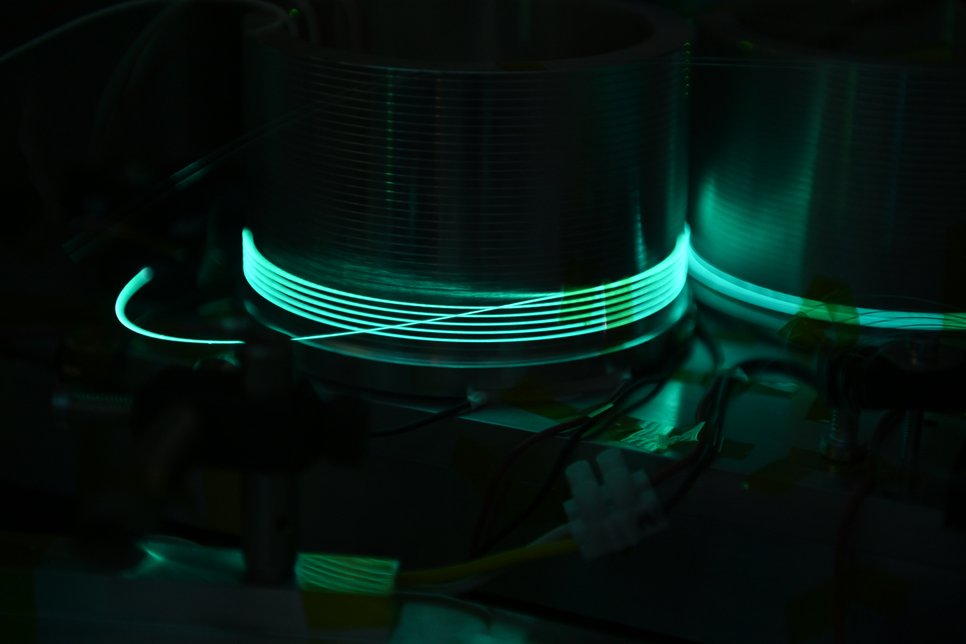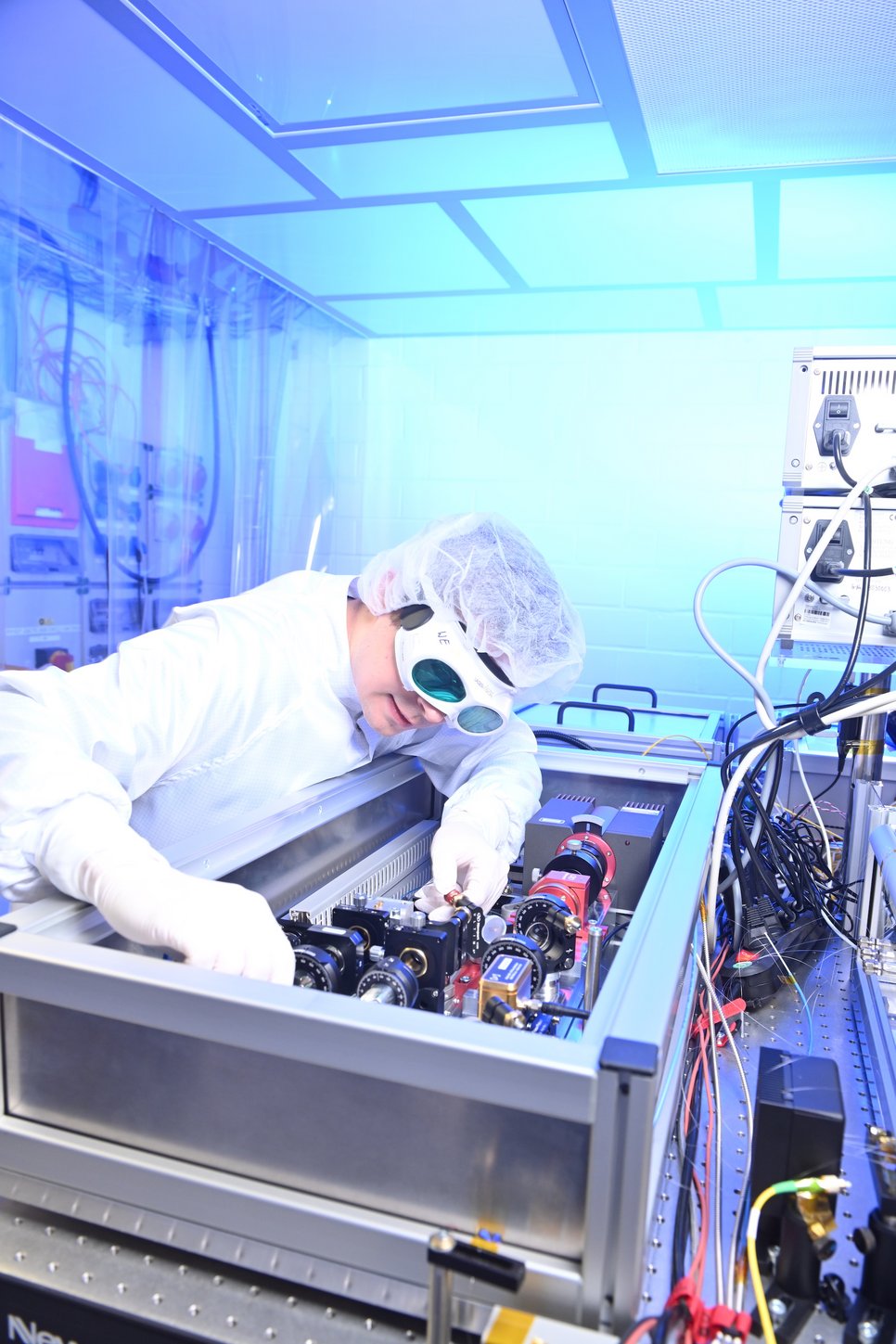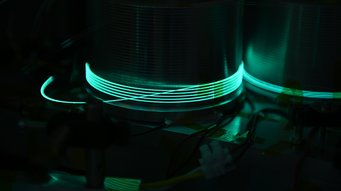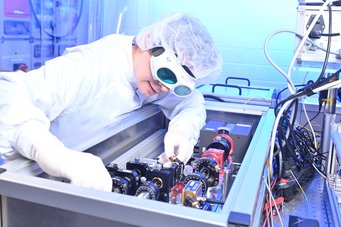A brighter future for gravitational-wave astronomy
Hannover research team develops most powerful laser system yet for gravitational-wave detectors
Future gravitational-wave detectors on Earth will use laser light with even higher power than in current instruments. Researchers from the Max Planck Institute for Gravitational Physics (Albert Einstein Institute, AEI), the Laser Zentrum Hannover e.V. (LZH), and Leibniz University Hannover have now developed a new laser system for this purpose. They combined the custom tailored light from two high-power lasers so precisely that it meets the requirements for use in gravitational-wave detectors. In a next step, the researchers will improve their system at AEI so that it can be used as a centerpiece for next-generation detectors. The results have now been published in the journal Optics Express.
Third-generation gravitational-wave detectors such as the Einstein Telescope or Cosmic Explorer will be about ten times more sensitive in detecting gravitational waves than the current large detectors LIGO, Virgo, and KAGRA. One of the key ingredients for this significant increase in sensitivity: highly precise and powerful laser sources with an output of up to 700 watts, which are used to detect length changes in the detector arms caused by gravitational waves. By comparison, LIGO’s current laser sources run at 70 watts.
Best laser light for most precise measurements

The quality of the laser (its color, brightness, beam shape, and beam alignment) must always be the same and meet the most stringent requirements. Otherwise, the measurement of gravitational waves would be impossible. To achieve high output power while maintaining the highest and most consistent beam quality, laser light generated in certain optical fibers is considered a promising candidate.
“By combining the fiber lasers we developed, it should be possible to achieve laser light of high power and high quality – as required in future gravitational wave detectors,” explains Felix Wellmann, head of the Fiber Optics Group in the Laser Development Department at Laser Zentrum Hanover e.V. and first author of the study published today in the journal Optics Express.
“This is exactly the approach we took and we showed in our study that splitting, amplifying and recombining two laser beams actually works as well as expected,” adds Nina Bode, a PhD student at the Max Planck Institute for Gravitational Physics and the Institute for Gravitational Physics at Leibniz University Hanover and second author of the paper.
Split, amplify and recombine

The research team started with a tried-and-true principle: They began with light from a very precise low-power laser. They split this into two beams and amplified this laser light in special glass fibers to about 200 watts each. These two high-power laser beams were then prepared using control electronics and mechanics so that their light waves oscillated almost perfectly in unison and could be effectively recombined. The result: up to 400 watts of laser power at a wavelength of 1064 nanometers in the infrared, which is also used by all of today's gravitational-wave detectors.
To determine its suitability for interferometric gravitational wave detectors, the researchers took a close look at the generated laser light: the brightness, beam orientation, beam shape, and color of the generated laser light are at a level that would allow it to be used in gravitational-wave detectors.
Next step: Active stabilization in an AEI laboratory
However, as in current instruments, the beam quality of the laser light must be continuously controlled and actively stabilized. Plans for this next improvement are already made. The newly developed system will be equipped with components for this currently missing step in a laboratory at the Albert Einstein Institute.
“From our years of experience with the laser systems of the large gravitational-wave detectors, we know how the active stabilization of the laser can be implemented,” explains Nina Bode. “We are confident that this procedure will also be successful with our new laser system and are excited to investigate this in detail.”
The world's best lasers from Hanover
Almost all laser systems currently in use at the large gravitational-wave detectors were developed at AEI Hanover together with the LZH. Only recently, scientists from AEI together with international colleagues described in a technical publication the stabilized high-power laser used by the LIGO instruments in their third observation run O3. It delivered up to 70 watts of laser power. In the same publication, they also describe a prototype of a stabilized high-power laser with up to 140 watts power output, which should make the LIGO detectors even more sensitive in their next observing run, O4.
“With these new results, AEI Hanover and the LZH demonstrate that they continue to play the worldwide leading role in the development and operation of the high-precision laser systems at the heart of gravitational-wave detectors,” says Benno Willke, head of the Laser Development group at the Max Planck Institute for Gravitational Physics and the Institute for Gravitational Physics at Leibniz Universität Hanover.
The work was funded, among others, by the German Research Foundation within the framework of the Cluster of Excellence QuantumFrontiers.

